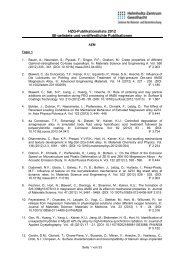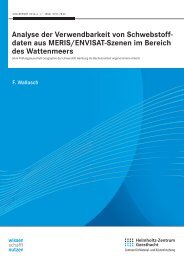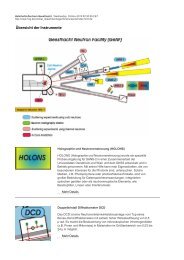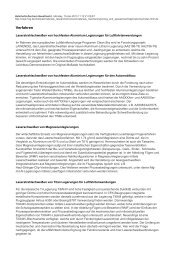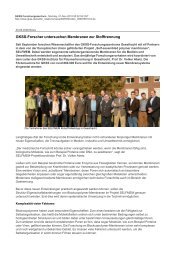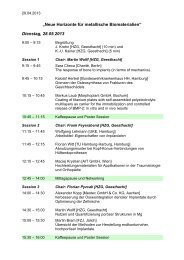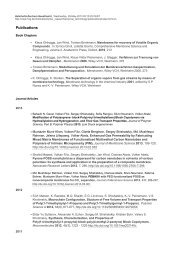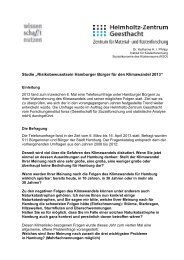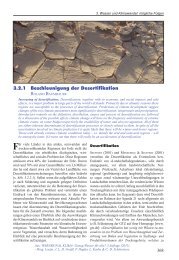Landfills and waste water treatment plants as sources of ... - GKSS
Landfills and waste water treatment plants as sources of ... - GKSS
Landfills and waste water treatment plants as sources of ... - GKSS
You also want an ePaper? Increase the reach of your titles
YUMPU automatically turns print PDFs into web optimized ePapers that Google loves.
INTRODUCTION<br />
Mabury 2006). This incre<strong>as</strong>e is probably related to the withdrawal <strong>of</strong> PSOF-b<strong>as</strong>ed products by<br />
the 3M Company (Stock et al. 2004).<br />
Since the 1960s, PBDEs are produced by bromination <strong>of</strong> diphenyl ether in the presence <strong>of</strong> an<br />
Friedel-Craft catalyst in a solvent (Alaee et al. 2003). The bromination process is fairly<br />
specific due to the directing oxygen atom <strong>and</strong> steric hindrance, resulting in a limited number<br />
<strong>of</strong> PBDE congeners. Therefore, commercial formulations that are manufactured contain<br />
specified congeners <strong>of</strong> brominated diphenyl ethers (BDEs) (Rahman et al. 2001). Commercial<br />
pentaBDE mixture usually consists <strong>of</strong> BDE47 (24- 38 %), BDE82, BDE85, BDE99, BDE100<br />
(50- 62 %), BDE153 <strong>and</strong> BDE154 (4-8 %). OctaBDE mixtures comprise congeners BDE153,<br />
BDE154 (10-12 %), BDE183 (43-44 %), octaBDE (31-35 %) <strong>and</strong> nonaBDE (9-11 %) <strong>as</strong> well<br />
<strong>as</strong> around 1 % <strong>of</strong> BDE209. In contr<strong>as</strong>t, decaBDE is predominantly composed <strong>of</strong> BDE209 (97-<br />
98 %) with small amounts <strong>of</strong> nonaBDE (Darnerud et al. 2001).<br />
In general, the use <strong>of</strong> PBDEs <strong>as</strong> flame retardants is in relation to their bromination level.<br />
PentaBDE mixtures are mainly added to polyurethane foams (PUF). PUF are applied to car<br />
interiors, carpets, furniture <strong>and</strong> pillows (Prevedouros et al. 2004). Furthermore, small amounts<br />
<strong>of</strong> pentaBDE have been applied to electronic housings, textiles <strong>and</strong> packaging. In contr<strong>as</strong>t,<br />
highly brominated mixtures such <strong>as</strong> octa- <strong>and</strong> decaBDE are almost entirely used in dense<br />
thermopl<strong>as</strong>tics, such <strong>as</strong> television <strong>and</strong> computer housings (Hale et al. 2002; Alaee et al. 2003).<br />
The worldwide consumption <strong>of</strong> PBDEs in 2001 w<strong>as</strong> 67000 t (Watanabe 2003). DecaBDE<br />
accounted for 83 % where<strong>as</strong> pentaBDE <strong>and</strong> octaBDE account for a smaller proportion with<br />
12 % <strong>and</strong> 5 %, respectively (Watanabe 2003). In 2003, the production volume <strong>of</strong> decaBDE<br />
mixture w<strong>as</strong> estimated to be 56000 t (Christiansson et al. 2009). The usage <strong>of</strong> PBDE products<br />
differ considerably between the continents. Compared to North America, Europe <strong>and</strong> Asia<br />
have rather low consumption <strong>of</strong> penta- <strong>and</strong> octaBDE mixtures (Kierkegaard et al. 2009). In<br />
contr<strong>as</strong>t to PFCs, estimates on the historical production <strong>of</strong> PBDEs are very limited. However,<br />
Prevedouros et al. (2004) calculated the European production <strong>and</strong> consumption <strong>of</strong> pentaBDE<br />
from 1970 to 2000 between 3000 <strong>and</strong> 5000 t. Furthermore 9000 to10000 t were imported in<br />
finished products. Starting in 1980, consumption <strong>of</strong> pentaBDE incre<strong>as</strong>ed rather constantly to<br />
1200 t in the mid <strong>of</strong> the 1990s. From thereon, a rapid decline to about 200 t in 2000 w<strong>as</strong><br />
estimated. Overall, production in North America <strong>and</strong> Europe is about to decline, due to<br />
voluntary <strong>and</strong> restrictive ph<strong>as</strong>e-outs (see section 1.4.6) <strong>of</strong> octa- <strong>and</strong> pentaBDE (<strong>and</strong> partly<br />
decaBDE) (de Wit et al. 2009).<br />
8






